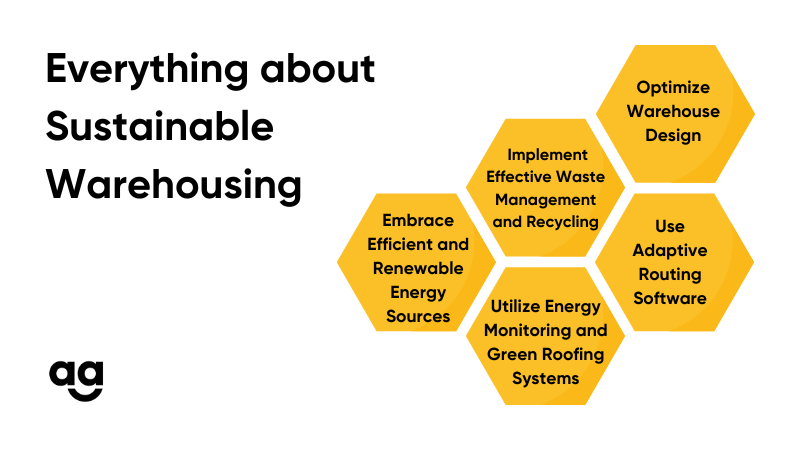Planning Pays Off: 5 Strategies to Get the Most Out of Your Delivery Speed Choice
August 22, 2024
6 min read
Introduction
Using green practices is essential to cutting down on waste, pollution, and energy use while increasing the profitability and productivity of your company. These procedures can also increase the profitability and productivity of your company. Using sustainable practices has advantages for the environment as well as improving the company’s reputation and increasing client loyalty.
Continue reading to learn five doable tactics to turn your warehouse into a sustainable role model.

5 Ways to Increase Warehouse Sustainability
Here are five essential strategies to increase the sustainability of your warehouse:
Embrace Efficient and Renewable Energy Sources
Choose energy-efficient LED lights and upgrade to energy-saving HVAC systems and smart thermostats in your distribution warehouse to cut energy bills and costs while supporting sustainability.
Install motion sensors and solar panels to save even more electricity. Finally, make sure to regulate the temperature and upgrade the insulation in your warehouse distribution center.
Implement Effective Waste Management and Recycling
Use environmentally friendly packing materials, such as those made of cornstarch or mushrooms, to make your cooperative warehousing viable. These biodegradable items will assist you in avoiding adding more garbage to landfills.
Do not use extra packaging size to save transportation costs, avoid resource waste, and prevent extra pollution. Additionally, ensure that your warehousing and storage solution has various recycling counters throughout its area. Here, your employees can segregate the material properly into categories like paper, plastic, and metal.
These will make recycling initiatives easier and encourage your suppliers and vendors to take back material that they can reuse. This eco-friendly practice will also help control production waste.
Optimize Warehouse Design
Design your warehouse layout based on your inventory’s location and movement patterns. This will minimize forklift travel distances and reduce space waste. Efficient layout planning helps conserve resources, cut costs, and ensure that lighting, cooling, and heating are applied where needed, improving overall energy use.
Utilize Energy Monitoring and Green Roofing Systems
If you want to improve the energy use and management of your warehousing and storage solutions, you must use energy monitoring systems. These smart systems will identify the pattern of energy use and help make real-time adjustments to improve efficiency.
Also, use green roofing systems, as they offer improved insulation that will improve your energy efficiency. They will also help you reduce stormwater runoff, boosting the biodiversity of the surrounding areas.
Use Adaptive Routing Software
Use adaptive routing software to optimize your logistics activities and reduce carbon emissions. This technology identifies the most efficient delivery routes and distribution centers, helping to minimize travel time, cost, and distance.
By leveraging AI, the software provides accurate recommendations based on various factors, such as destination, size, weight, and delivery time. It also offers options for multiple carriers and pick-up locations, enhancing cost-efficiency and operational effectiveness.
Conclusion
With the increasing popularity of sustainability and eco-friendly practices, it is important that you implement them to retain your customers. This will not only ensure the continued success of your warehouse company but also help you boost your everyday profits.
Partnering with solutions like Shipyaari can further advance your sustainability goals. Shipyaari’s advanced logistics technology helps streamline shipping processes, reduce waste, and improve overall efficiency, aligning with your commitment to environmental responsibility.
So why wait? Try it for free now!
Frequently Asked Questions
High upfront expenses, the requirement for staff training, and coordinating your sustainability goals with organizational goals are some of the difficulties you may encounter. Furthermore, major adjustments to current infrastructure and procedures may be necessary for the integration of new technology and practices.
Using sustainable techniques in your industrial warehouse can improve worker safety, reduce dangers, and improve air quality.
Additionally, these practices frequently entail updating tools and refining protocols, which can further improve worker wellbeing and workplace safety in general.
You may minimize the impact on the environment by optimizing energy use, lowering human error, and improving overall operational efficiency at the warehouse distribution center by automating your processes.
Adopting sustainable warehousing techniques improves delivery operations by streamlining transportation routes. It frequently results in a rise in the use of electric or hybrid cars and cuts down on pointless travel, which dramatically lowers emissions and fuel consumption. This lowers operating expenses and makes the supply chain more environmentally friendly.
Suggested Reads
Hyperlocal Personalization: Tailoring Experiences for Local Customers
Introduction The eCommerce industry in India has witnessed a rapid growth of hyperlocal services in
Continue ReadingDec


















 Shipping
Shipping







